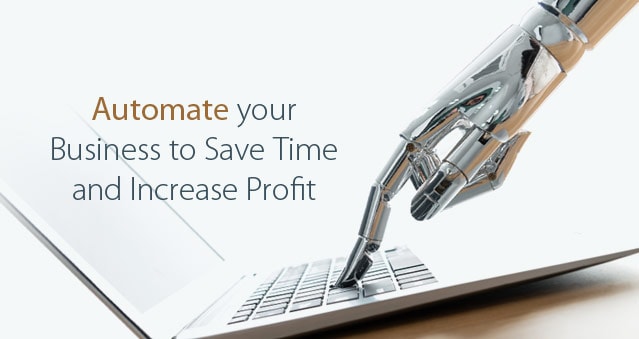The one thing all companies have in common is their desire to prosper and grow. While many organizations have automated various aspects of the business such as sales, customer service, inventory management, supply chain, delivery, etc., a critical component of every business (their financial processes) has often been overlooked. So if you’re trying to determine how to automate the billing process, this blog breaks it down.
Is it Time for Your Company to Automate Billing Processes?
Depending on the organization, it may be obvious if automating your financial processes needs to move to the top of your priority list. If you’re unsure, take a look at the following questions to determine if now’s the time to swap labor-intensive manual billing processes for automation.
- Is your finance team manually handling repetitive tasks?
- The time it takes to process an order can vary, but on average it takes 5 times longer without automation. Would you like to speed your order processing time?
- Does it take days or even weeks of research to identify outstanding payments, delaying follow-up on overdue accounts?
- When a customer requests an upgrade or downgrade do you need to cancel their subscription (or part of the subscription), replace the subscription, and make manual changes on the back end to ensure accurate revenue recognition?
- Is your financial team closing the books at the end of each month using spreadsheets?
- Does it take an excessive amount of time and an impossible number of reports to gauge the health of your business (total customer value (TCV), monthly recurring revenue (MRR), annual recurring revenue (ARR), cash flow, customer churn, customer lifetime value (CLV), product and/or services sales, revenue earned, etc.)?
- Do you struggle to obtain reports that detail how well your pricing strategies are performing?
If you answered yes to one or more of these questions, your business is ready for automated billing. Before moving on there is one last question… do you want to position your company for growth?
How to Automate The Billing Process
As your company grows, manual efforts typically result in increased errors, which many times has a downstream effect on your profitability. Although many companies are moving to an automated billing system, finding the right billing platform can be challenging. To help you on this quest, we’ve outlined the six most critical aspects that you need to consider.
- Start the process by reviewing your pricing plans. This includes subscription billing, usage-based billing, dynamic billing, and hybrid billing, as well as pricing bundles, packages, promotions, and discounts. Be sure to consider potential future pricing models during this phase of the process. You want to ensure that the billing system you select can efficiently handle today’s pricing models, as well as tomorrow’s.
- The system should have integrated workflow automation capabilities. This allows automation of key business processes around events, attributes, and/or time. For maximum productivity and minimal manual effort, it should provide a simple point-and-click interface. Plus allow you to set up and orchestrate workflows involving multiple steps.
- Ensure you’re able to split large invoices with numerous charges into smaller invoices that are individually approved and sent to the customer once the product is delivered or service rendered. Referred to as event-based invoicing, this functionality allows you to define invoicing cycles based on a single event or group of events that signal the close and delivery of an invoice.
- Customers want a choice when it comes to payments. Be sure the system allows for a variety of secure payment options, such as debit cards, credit cards, ACH, checks, PayPal, etc. In addition, if you sell globally or plan to sell on an international level, you’ll need a billing system that has built-in internationalization and includes functionality for localization, multi-currency, multiple languages, and regional taxation.
- The billing system needs the ability to automatically generate invoices, as well as accept payments. However, automation shouldn’t end there, you also need to automate credits, refunds, dunning, and collections.
- Finally, ensure you’re always compliant with ASC 606 and IFRS 15, revenue recognition so that you only recognize revenue when performance obligations are met.
Manually managing billing can, and does, lead to errors like missed calculations. Then the time and effort spent correcting mistakes is both time-consuming and costly. Want to dig a bit deeper into requirements for billing automation? Check out our 7 Questions to Clarify Your Requirements for Automated Billing blog.
Integrating Billing Automation with Your Financial Tech Stack
Billing automation delivers the most value when it’s fully integrated with the rest of your financial systems. Without those connections, teams still struggle with duplicate entry, reconciliation delays, and incomplete visibility. By integrating your billing platform with ERP, CRM, CPQ, tax compliance tools, and payment gateways, you create a real-time billing system that synchronizes data across every department.
Trigger-based workflows extend the benefit. A contract signed in Salesforce or HubSpot can automatically initiate an invoice through automated billing software, eliminating delays between sales and finance. This kind of workflow reduces errors, accelerates billing cycles, and supports more consistent cash flow.
It also provides finance teams with a single view of all activity, which is vital for long-term planning. When paired with automated revenue recognition, these integrations improve confidence in reported numbers and reduce the burden of compliance.
Integration also strengthens audit-readiness. Shared data across systems produces cleaner reports, faster period closes, and reliable compliance documentation – especially valuable for organizations managing high volumes of subscriptions. By reducing IT dependency, modern billing platforms make these integrations easier through APIs and prebuilt connectors, empowering finance teams to manage data flows with minimal coding.
For businesses exploring how to automate subscription billing, the ability to connect billing with accounting software, payments, and CRM is no longer optional – it’s the foundation for accurate forecasting, efficiency, and scalable growth.
Learn more about automated billing for complex business models.
Overcoming Common Barriers to Billing Automation
Even though the benefits are clear, many companies hesitate to modernize their billing. Legacy systems often feel too embedded to replace, and the idea of migration sparks concern. The reality is that outdated, custom-coded platforms create higher risk and cost over time. Cloud-based solutions reduce migration complexity by offering modular onboarding, data-mapping tools, and flexible deployment strategies.
Change management is another hurdle. Teams may worry about disruption or the learning curve associated with new platforms. Modern billing vendors anticipate this, providing guided implementation, role-based training, and phased rollouts that ease the transition.
With proper planning, organizations move quickly from manual invoice processing to automated invoice processing without losing momentum. These transitions also demonstrate to employees that automation is designed to simplify their work, not replace it.
Internal misalignment can slow adoption as well. Successful projects depend on finance and IT collaboration from the start, with shared goals and clear technical requirements. When both teams buy into the vision, billing automation becomes less of a technology project and more of a business transformation.
Lastly, there’s the build vs. buy debate to consider. While custom-built systems once seemed appealing, they’re costly to maintain and lack scalability. Today, specialized SaaS platforms are designed to support everything from recurring billing automation to quote-to-cash automation, freeing resources and delivering faster ROI.
Learn more about why automation is key to revenue growth from our blog.
Using Workflow Automation to Enforce Billing Governance
Automation isn’t only about efficiency – it’s also about governance. Rule-based workflows make it possible to enforce internal billing policies consistently across departments. Approvals can be automatically required for high-value invoices, significant discounts, or contract modifications. This governance-first approach helps reduce compliance risk and improves financial accuracy.
Role-based control strengthens these safeguards. By defining who can trigger, modify, or approve specific billing events, organizations protect sensitive processes. Combining this with dunning automation tools provides consistent handling of overdue accounts, reducing disputes and keeping receivables on track.
Every transaction is documented through automated logs and time-stamped approvals. This creates a complete audit trail for internal oversight, regulatory requirements, and dispute resolution. Over time, the ability to demonstrate clear and consistent workflows becomes a competitive advantage during audits and negotiations.
Platforms with extensible workflows can even adapt processes – auto-generating invoice adjustments tied to SLA breaches, triggering collections based on aging thresholds, or applying account-specific rules. Workflow-driven governance turns automated invoicing from a back-office tool into a compliance asset, protecting revenue while maintaining operational agility.
Adapting Billing Automation for Global Operations
Global companies face challenges that manual billing cannot keep up with. Tax compliance, regulatory mandates, and regional invoicing requirements add layers of complexity that demand automation. A modern billing platform handles VAT/GST calculations, e-invoicing compliance, and localized templates at scale, reducing risk and accelerating growth.
Localization goes beyond tax codes. Automated systems generate invoices and communications in the customer’s preferred currency and language. From automated invoices with correct local tax rules to customer notifications aligned with regional formats, automation improves accuracy and customer confidence. Businesses also gain flexibility when markets change – adjusting tax structures, introducing new product bundles, or supporting regional promotions without rebuilding processes.
For enterprises with multiple subsidiaries, billing cycle automation supports each entity’s financial calendar, while rolling up results into consolidated reports. This dual-level visibility helps corporate leadership track performance globally while respecting local compliance needs.
Cross-border commerce also benefits. Integration with local payment gateways enables smoother payment processing automation, while currency conversion tools eliminate friction in international transactions. For organizations evaluating how to automate enterprise billing processes for global operations, automation provides the scalability and compliance coverage required to compete worldwide.
How Billing Automation Enhances the Customer Experience
Billing automation is not just an internal efficiency gain – it directly impacts customer satisfaction. With timely, accurate invoices and automated receipts, customers experience fewer errors and disputes. This reliability builds trust and reduces churn, especially for subscription-based businesses relying on predictable recurring payment cycles.
Automation also supports real-time responsiveness. When a customer upgrades their plan or adds services, a real-time billing system instantly reflects the change. This reduces frustration, eliminates manual delays, and empowers customers to control their accounts with confidence.
Self-service capabilities further enhance the experience. Through automated workflows and customer portals, clients can manage their payment preferences, view their automated invoices, and resolve billing issues without waiting for support. These features not only reduce support tickets but also give customers ownership of their accounts, which boosts satisfaction.
In global markets, these benefits multiply. Localized billing options, flexible payments, and accurate tax handling create a seamless experience regardless of geography. For organizations looking to boost loyalty, billing automation becomes part of the customer journey itself.
Explore how billing automation supports digital transformation and see how it can reshape engagement, or learn how to streamline quote-to-cash.
Reap the Benefits of Billing Automation
When you automate billing processes, you gain both speed and efficiency. However, there’s one thing to keep in mind when selecting a billing platform vendor. The billing system needs to conform to your business, not the other way around.
BillingPlatform’s cloud-based billing platform enables you to easily automate the entire quote-to-cash process. We give companies, like yours, the power to enable any kind of pricing model, bring new and innovative products and services to market faster, reduce operational spend, and deliver a frictionless customer experience. Learn more about how we can help by reaching out to our team of experts today!



